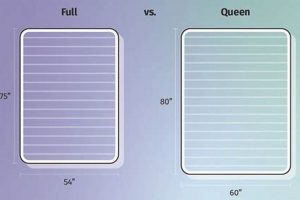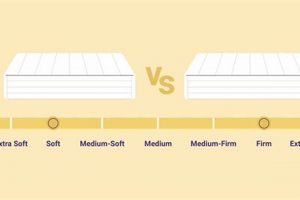A key consideration when furnishing a bedroom is selecting the appropriate size mattress. Two popular options are the wider king and the longer California king. The dimensions of each differ, with the standard king offering greater width, while the California king provides additional length. These differences in dimension impact the suitability of each mattress type for varying room sizes and individual needs. For instance, a taller individual may benefit from the increased length offered by the California king.
The selection between these mattress sizes can significantly impact sleep quality and overall comfort. The additional space offered by either option can be particularly beneficial for couples or individuals who prefer more room to move during sleep. Historically, mattress sizes have evolved to accommodate changing needs and preferences related to comfort and available space in homes.
Understanding the specific dimensions, room size considerations, and individual sleep preferences is crucial to making an informed decision. Factors such as bedroom layout, the sleeper’s height, and whether the bed will be shared all play a role in determining the optimal mattress size. The subsequent discussion will delve deeper into these factors to assist in making the appropriate selection.
Selection Considerations
Choosing between mattress sizes requires careful assessment of individual needs and room specifications. Several factors should be weighed to ensure optimal comfort and functionality.
Tip 1: Room Dimensions Assessment: Measure the intended bedroom space prior to selection. Smaller rooms may benefit from the relatively narrower width of a California king, while larger rooms can accommodate the substantial width of a standard king.
Tip 2: Height Consideration: Taller individuals often find the additional length of the California king provides greater comfort and prevents feet from hanging off the end of the mattress. A standard king may be sufficient for individuals of average height.
Tip 3: Sleeping Partner Preferences: If co-sleeping, consider each partner’s movement during sleep. The greater width of the standard king may offer more personal space, reducing disturbances during the night.
Tip 4: Bedding Availability: Standard king bedding is more readily available and often less expensive than California king-sized bedding. This factor can influence the long-term cost of ownership.
Tip 5: Frame Compatibility: Verify that the chosen bed frame is specifically designed for the selected mattress size. Using an incompatible frame can lead to structural issues and reduce mattress lifespan.
Tip 6: Transportation Considerations: The elongated shape of the California king can present challenges during transportation and maneuvering within a home. Assess accessibility prior to purchase.
Tip 7: Budget Allocation: California king mattresses typically command a higher price due to their specialized dimensions. Factor this increased cost into the overall budget planning.
Careful consideration of these factors ensures that the chosen mattress effectively addresses individual needs, optimizes bedroom space, and promotes restful sleep. Prioritization of these elements contributes to a more informed purchasing decision.
The following sections will explore other relevant aspects and potential product examples related to these mattress types.
1. Dimensions
The defining characteristic between mattress types resides in their dimensions. A standard king mattress typically measures 76 inches in width and 80 inches in length. Conversely, a California king mattress measures 72 inches in width and 84 inches in length. This seemingly subtle difference has a considerable impact on suitability for specific needs and room layouts. The standard king prioritizes width, offering more lateral space for co-sleepers, while the California king prioritizes length, catering to taller individuals. Consider, for instance, a couple who value personal space; the standard king’s added width could prove more beneficial. Conversely, an individual exceeding six feet in height may find the California king’s extended length more comfortable, preventing their feet from hanging off the edge.
The practical significance of understanding these dimensional differences extends beyond individual comfort. Room size is a critical constraint. A narrow bedroom may better accommodate the slightly narrower California king, allowing for easier navigation around the bed. Furthermore, furniture placement must be considered. The extra width of a standard king can impede the placement of nightstands or other bedroom furnishings. Another consideration is bedding compatibility. Sheets, comforters, and other bedding items are specifically sized for each mattress type. Attempting to use standard king bedding on a California king, or vice versa, results in an ill-fitting and potentially uncomfortable sleep experience.
In summary, the dimensional disparity is a fundamental determinant in selecting between mattress types. These seemingly small dimension differences are impactful considerations based on individual sleeper height and room size. The choice necessitates a careful assessment of individual needs and spatial constraints to ensure optimal comfort and functionality. The implications extend to bedding compatibility and overall bedroom layout, emphasizing the importance of a thorough understanding of dimensions prior to purchase.
2. Room Size
The size of the bedroom dictates the practicality of accommodating a king or California king mattress. The physical dimensions of these mattresses directly impact the available space within a room, influencing both movement and the placement of other furniture. Smaller bedrooms may become cramped with a standard king, hindering accessibility and creating a sense of confinement. Conversely, a large room could easily accommodate either mattress type, providing ample space for movement and additional furniture. A room that is 12 feet by 12 feet could accommodate a California King, but that would not take into account other furnishings that are placed within the room.
The correlation between room size and mattress selection is causal: room dimensions directly limit mattress options. Attempting to fit an oversized mattress into a small room results in a compromised living space. This has an impact on the ease of navigation and potentially obstructing doorways or hindering access to closets. A more appropriate solution is to measure a bedroom to ensure enough space for a mattress so the bedroom stays functional. The primary goal is to create a comfortable and functional sleeping environment. This illustrates the importance of careful measurement and spatial planning prior to purchasing a new mattress.
In summary, room size serves as a primary constraint in the selection process. It has influence over both the physical comfort of a space and the functionality of a bedroom. Disregarding these spatial considerations leads to a compromised living environment. Accurate measurements and a clear understanding of room layout are essential steps in ensuring the selected mattress size complements the available space. This ensures a comfortable and aesthetically pleasing bedroom environment.
3. Body Height
Body height is a crucial factor when determining the suitability of a mattress. The relative length of a mattress compared to an individual’s height directly impacts sleep comfort and support. Selecting an inappropriately sized mattress can lead to discomfort, disrupted sleep, and potential health issues.
- Leg Support and Spinal Alignment
A mattress that is too short can result in the sleeper’s feet hanging off the edge, leading to inadequate leg support. This misalignment can strain the spine and hip joints, potentially causing lower back pain and discomfort. The California king, with its additional length, is often recommended for individuals exceeding six feet in height to ensure proper leg support and spinal alignment.
- Pressure Point Relief
If a mattress is too short, the body may be forced into a curled or fetal position, increasing pressure on specific points such as the hips and shoulders. This can exacerbate existing joint pain or lead to the development of new pressure sores. A longer mattress allows the body to stretch out fully, distributing weight more evenly and reducing pressure point stress.
- Restless Sleep and Discomfort
Inadequate mattress length can contribute to restless sleep as the individual constantly adjusts their position to find a comfortable posture. This interrupted sleep cycle can lead to fatigue, irritability, and reduced cognitive function during the day. A mattress that accommodates the individual’s full height promotes undisturbed and restful sleep.
- Partner Accommodation
When sharing a bed, body height becomes a critical consideration for both individuals. If one partner is significantly taller, a California king may be necessary to accommodate their needs, even if the other partner would be comfortable on a standard king. Compromise on mattress length can lead to discomfort and disrupted sleep for the taller individual, impacting the overall sleep quality of both partners.
Therefore, body height should be a primary consideration when choosing between mattress types. Prioritizing adequate mattress length ensures proper support, spinal alignment, and pressure point relief, leading to improved sleep quality and overall well-being. The decision between a standard king and a California king should be guided by the height of the individual(s) who will be sleeping on the mattress, rather than solely by room size or aesthetic preferences.
4. Bedding Costs
The overall expense associated with either mattress type is significantly influenced by the cost of compatible bedding. Standard king bedding, due to its wider availability and higher production volumes, tends to be less expensive than its California king counterpart. This price disparity stems from the California king’s specialized dimensions and lower production quantities, leading to increased manufacturing and retail costs. For example, a high-quality sheet set for a standard king might be priced at $150, while a comparable set for a California king could easily exceed $200. Over the lifespan of a mattress, these cumulative bedding costs can represent a substantial portion of the overall investment. This aspect is important for consumers to be aware of, as it affects their long-term budget. It is a factor that should be weighed accordingly with room size and individual height when making a mattress selection.
Beyond initial purchase costs, replacement bedding and specialty items, such as mattress protectors and decorative shams, also exhibit this pricing trend. Finding sales or discounted items for standard king bedding is typically easier than for California king sizes, offering further opportunities for cost savings. Consumers on a budget may find the wider selection and lower prices of standard king bedding to be a decisive factor in their mattress choice. Additionally, individuals with specific bedding needs, such as those requiring organic cotton or hypoallergenic materials, might encounter a narrower selection and higher prices within the California king size range. This limitation can further increase the overall bedding expenses associated with this mattress type.
In summary, the cost of bedding represents a significant and ongoing expense associated with mattress ownership. The relative scarcity and specialized dimensions of California king bedding contribute to higher prices compared to standard king bedding. This difference in cost should be carefully considered alongside other factors such as room size and individual height to make an informed mattress selection that aligns with both comfort needs and budget constraints. Ignoring this aspect can lead to unexpected financial burdens and limit bedding options over time.
5. Sleeping Style
Sleeping style significantly influences the choice between mattress types. Individuals adopt varying sleep positions, each demanding specific support and space considerations. Side sleepers, for instance, often benefit from a mattress that allows ample room to bend their knees without constraint. Back sleepers require a surface that maintains spinal alignment. Stomach sleepers, though less common, need a firm surface to prevent excessive arching of the back. These stylistic preferences directly affect the perceived comfort and suitability of a mattress. For example, an active sleeper who frequently changes positions may find the wider surface of a standard king mattress more accommodating, preventing them from rolling off the edge during the night. Conversely, a primarily supine sleeper concerned with legroom might prioritize the added length of a California king. Thus, sleeping style acts as a primary determinant in optimizing sleep quality.
Furthermore, the combination of sleeping style and co-sleeping arrangements compounds the importance of mattress selection. Couples with differing preferred sleep positions must consider a mattress that caters to both needs. If one partner is an active sleeper while the other prefers stillness, the additional width of a standard king can minimize disturbances. However, if one partner is significantly taller and tends to sprawl out, a California king may offer a better compromise by providing sufficient length without sacrificing too much width for the other partner. The practical application of this understanding involves observing sleeping habits and communicating preferences to ensure a mutually satisfactory outcome. Mattress trials, where available, allow for testing different sleeping styles on each mattress type before making a final decision.
In conclusion, sleeping style forms an integral link in the equation of mattress selection. It dictates the necessary support, space, and motion isolation characteristics for optimal sleep quality. While factors like room size and body height also play a role, neglecting the influence of preferred sleep position can lead to discomfort and disrupted rest. A comprehensive assessment of sleeping habits, both individually and in the context of a co-sleeping arrangement, is crucial for navigating the nuances and selecting the most appropriate mattress type. The challenge lies in balancing individual preferences with spatial constraints and budgetary considerations to achieve a harmonious sleep environment.
6. Space Needs
Space needs, in the context of mattress selection, pertain to the physical area required for comfortable sleep and the minimization of sleep disturbances. These needs are directly influenced by individual body size, preferred sleep position, and whether the bed is shared. The choice between a California king and a regular king mattress hinges significantly on assessing these spatial requirements. For instance, an individual who sprawls during sleep necessitates a larger surface area. Similarly, co-sleepers who value personal space must consider a mattress that provides adequate separation to prevent disruptions caused by movement. Therefore, space needs represent a critical input in the decision-making process, influencing the ultimate comfort and quality of sleep experienced. Real-world examples include couples who, despite having a large bedroom, opt for a regular king due to one partner’s tendency to move frequently during sleep, requiring the added width. Conversely, a taller individual living in a smaller apartment might prioritize a California king to accommodate their height, even if it means less walking space around the bed.
Understanding space needs extends beyond simply accommodating physical dimensions. It also encompasses the psychological aspects of comfort and security. A bed that feels too small can induce anxiety and restlessness, while one that provides ample space can promote a sense of relaxation and freedom. In practice, this translates to considering the perceived spaciousness of the mattress in relation to the individual’s body image and personal preferences. For example, someone accustomed to sleeping on a queen-sized bed might find a regular king overwhelming, even if the room can accommodate it. The sensation of having too much space can be just as detrimental to sleep quality as having too little. Therefore, a balance must be struck between meeting physical space needs and achieving a sense of comfort and security. Furthermore, the presence of pets or children sharing the bed also alters space needs, necessitating a larger mattress to accommodate all occupants comfortably. The significance of assessing all contributing factors when determining overall space requirements needs emphasis.
In summary, space needs serve as a primary determinant in the selection process between a California king and a regular king mattress. The decision must incorporate an assessment of physical dimensions, sleeping habits, co-sleeping arrangements, and psychological preferences. Failure to adequately address these needs can result in compromised sleep quality and a suboptimal bedroom environment. The challenge lies in accurately quantifying individual space requirements and aligning them with available room dimensions and budgetary constraints. By prioritizing this assessment, individuals can make a more informed choice, ensuring a comfortable and restful sleep experience.
Frequently Asked Questions
The following addresses frequently encountered queries concerning the selection between California king and regular king mattresses. Each question provides clarity and actionable information.
Question 1: What are the precise dimensional differences between a California king and a regular king mattress?
A regular king mattress measures approximately 76 inches wide by 80 inches long. A California king mattress measures approximately 72 inches wide by 84 inches long. The California king sacrifices width for additional length.
Question 2: Is a California king mattress always the better choice for taller individuals?
While the added length of a California king is generally beneficial for taller individuals, it is not universally applicable. Individuals exceeding six feet in height typically benefit most. However, other factors, such as sleeping style and the presence of a co-sleeper, should also be considered.
Question 3: Does a California king mattress require specialized bedding, and does that increase the overall cost?
A California king mattress requires bedding specifically designed for its dimensions. Due to lower production volumes and specialized sizing, California king bedding typically incurs a higher cost than standard king bedding. This difference in cost should be factored into the overall budget.
Question 4: How does room size impact the selection between these mattress types?
Smaller bedrooms may be better suited for the slightly narrower California king, allowing for improved maneuverability and furniture placement. Larger bedrooms can generally accommodate either mattress type. Room measurements should be taken prior to purchase to ensure adequate space.
Question 5: Is one mattress type inherently more comfortable than the other?
Comfort is subjective and depends on individual preferences. The ideal mattress type aligns with sleeping style, body size, and personal preferences. Neither mattress is inherently more comfortable; the selection should be based on individual needs.
Question 6: What are the potential disadvantages of choosing a California king mattress?
Potential disadvantages include higher bedding costs, limited availability of certain bedding items, and potential difficulties during transportation due to the mattress’s length. These factors should be weighed against the benefits of the added length for taller individuals.
In conclusion, selecting between these mattress types requires careful consideration of individual needs, room dimensions, and budgetary constraints. Prioritizing these factors ensures a well-informed decision.
The subsequent discussion will address specific product examples and relevant purchasing recommendations.
California King vs Regular King Mattress
The preceding analysis dissected the core distinctions between California king and regular king mattresses, elucidating the critical factors influencing selection. Room size, body height, sleeping style, bedding costs, and individual space needs emerged as primary determinants. The standard king prioritizes width, catering to co-sleepers and those valuing personal space. The California king offers enhanced length, better suiting taller individuals. The decision necessitates a careful evaluation of these competing priorities to optimize sleep quality and overall comfort.
The informed consumer, equipped with this knowledge, is now positioned to make a judicious purchase aligned with individual circumstances. The long-term investment in a quality mattress demands a rigorous assessment, considering both immediate needs and future preferences. Disregarding these considerations invites potential discomfort and compromised sleep. Therefore, a deliberate and thoughtful approach is essential for securing a sleep solution that provides lasting benefits. The optimal choice remains an individual determination, grounded in a clear understanding of personal requirements and spatial constraints.




![Saatva vs Leesa Mattress: Which Bed Wins? [2024] Organic & Natural Mattress Buyer’s Guide: Non-Toxic Sleep Solutions Saatva vs Leesa Mattress: Which Bed Wins? [2024] | Organic & Natural Mattress Buyer’s Guide: Non-Toxic Sleep Solutions](https://mattressworldpa.com/wp-content/uploads/2025/07/th-1084-300x200.jpg)


